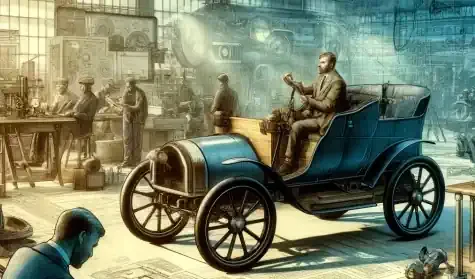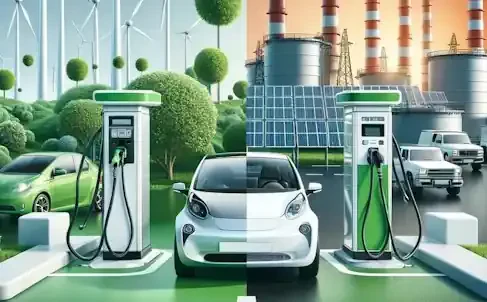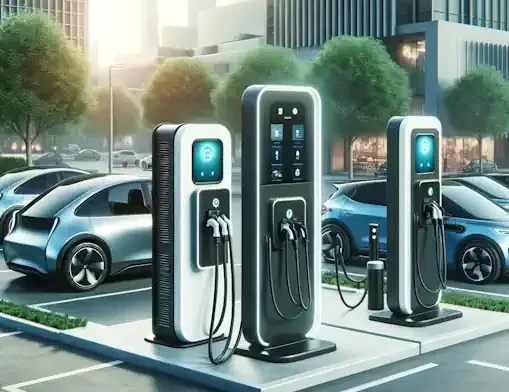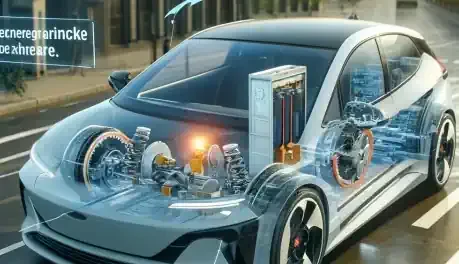Introduction
Electric vehicles (EVs) are no longer a mere novelty or a distant vision of the future; they have firmly cemented their place in the contemporary automotive landscape. With concerns about climate change, air pollution, and energy security mounting, EVs have emerged as a promising solution to address these pressing challenges. However, the roots of electric propulsion stretch far back into history, tracing their origins to the early experiments and innovations of the 19th century.
In the dawn of the industrial age, as steam power revolutionized transportation and industry, inventors and engineers began exploring alternative methods of propulsion. Among these alternatives, electric propulsion emerged as a viable contender, offering silent operation, zero emissions, and ease of use compared to its steam and internal combustion counterparts. Early pioneers such as Robert Anderson, who created one of the first crude electric carriages in the 1830s, laid the foundation for what would become a revolutionary mode of transportation.
The late 19th and early 20th centuries marked the heyday of electric vehicles. In urban centers around the world, electric cars, buses, and even taxis became a common sight, offering a cleaner and quieter alternative to the noisy, smoke-belching vehicles powered by internal combustion engines. Electric vehicles found favor among urban dwellers for their simplicity, reliability, and ease of operation. Innovations such as the storage battery, developed by pioneers like Gaston Planté and Thomas Edison, propelled the electric vehicle industry forward, enabling longer range and greater practicality.
However, the rise of the internal combustion engine presented formidable challenges to the dominance of electric vehicles. With the advent of mass production techniques pioneered by Henry Ford and the accessibility of cheap gasoline, internal combustion-powered automobiles quickly became the preferred choice for consumers. The rapid expansion of road infrastructure, coupled with the discovery of vast oil reserves, further solidified the dominance of gasoline-powered vehicles, relegating electric vehicles to niche applications such as delivery trucks, golf carts, and industrial vehicles.
Despite their decline in popularity, electric vehicles never faded into obscurity entirely. Throughout the 20th century, there were sporadic efforts to revive interest in electric propulsion, driven by concerns about air pollution, oil dependency, and the environmental impact of fossil fuels. Experimental projects, such as General Motors' EV1 and various electric delivery vehicles, demonstrated the potential of electric propulsion but failed to gain widespread acceptance due to limitations in battery technology, range, and infrastructure.
In recent decades, however, a confluence of factors has reignited interest in electric vehicles and propelled them back into the spotlight. Growing environmental consciousness, spurred by alarming reports of climate change and air pollution, has led governments and policymakers to enact stringent emissions regulations and incentivize the adoption of electric vehicles. Technological advancements in battery technology, electric motors, and charging infrastructure have overcome many of the limitations that once hindered the widespread adoption of electric vehicles, making them increasingly practical and affordable for consumers.
Today, electric vehicles stand at the forefront of a transportation revolution, challenging traditional notions of mobility and reshaping the automotive industry. With major automakers investing heavily in electric vehicle development and an ever-expanding network of charging stations proliferating around the world, the momentum behind electric vehicles shows no signs of slowing down. As we delve into the historical perspective of electric vehicles, we gain insight into their evolution from curious contraptions of the past to the driving force of the future.
Early Beginnings: The Birth of Electric Vehicles
The roots of electric vehicles extend back to the early experiments and innovations of the 19th century. In an era marked by rapid industrialization and technological advancement, inventors and engineers sought alternative methods of propulsion to complement or rival the steam engines that powered the locomotives, boats, and factories of the time.
Among these visionaries was Robert Anderson, a Scottish inventor credited with creating one of the first crude electric carriages in the 1830s. Anderson's vehicle, powered by non-rechargeable primary cells, represented a significant leap forward in the development of electric propulsion. Although Anderson's invention was rudimentary and impractical by modern standards, it laid the groundwork for future advancements in electric vehicle technology.
Throughout the 19th century, as the principles of electricity and electromagnetism were elucidated by scientists such as Michael Faraday and James Clerk Maxwell, interest in electric propulsion grew. Experimentation with electric motors, batteries, and control systems accelerated, leading to incremental improvements in the performance and efficiency of electric vehicles.
One of the most significant developments of this period was the invention of the rechargeable storage battery, which offered a means of storing and delivering electrical energy on demand. French physicist Gaston Planté is credited with inventing the first practical storage battery, known as the lead-acid battery, in 1859. Planté's invention revolutionized the field of electric propulsion, enabling the development of electric vehicles capable of traveling greater distances without the need for constant recharging.
Another pivotal moment in the history of electric vehicles came with the invention of the electric motor. In 1834, American physicist Thomas Davenport built the first practical DC electric motor, which he used to power a small model car. Davenport's motor demonstrated the feasibility of using electric propulsion for transportation purposes, inspiring subsequent inventors and engineers to refine and improve upon his design.
By the end of the 19th century, electric vehicles had emerged as a viable alternative to steam and internal combustion-powered vehicles, particularly in urban areas where their silent operation, zero emissions, and ease of use made them an attractive option for consumers. Electric cars, buses, and even taxis became a common sight on the streets of cities such as London, Paris, and New York, heralding a new era of clean, efficient transportation.
Despite their early promise, electric vehicles faced stiff competition from internal combustion-powered vehicles, which benefited from advances in mass production techniques, the availability of cheap gasoline, and the rapid expansion of road infrastructure. The rise of the internal combustion engine posed significant challenges to the dominance of electric vehicles, leading to a decline in their popularity in the early 20th century.
Nevertheless, the innovations and advancements made during the formative years of electric vehicle development laid the foundation for future breakthroughs in battery technology, electric motors, and charging infrastructure. As we reflect on the early beginnings of electric vehicles, we gain a deeper appreciation for the ingenuity and foresight of the pioneers who paved the way for the transportation revolution that continues to unfold today.
The Rise of Electric Vehicles in the Late 19th and Early 20th Century
The late 19th and early 20th centuries witnessed the rapid rise of electric vehicles as a popular mode of transportation, particularly in urban areas. During this period, electric cars, buses, and taxis proliferated on the streets of major cities around the world, offering a cleaner, quieter alternative to the noisy, smoke-belching vehicles powered by internal combustion engines.
One of the key factors driving the popularity of electric vehicles during this time was their suitability for urban transportation. In densely populated cities where pollution and noise were becoming increasingly problematic, electric vehicles offered a welcome respite. Their silent operation and zero emissions made them well-suited for navigating crowded city streets and congested traffic conditions, earning them favor among urban dwellers seeking a more pleasant and sustainable mode of transportation.
Electric vehicles also gained traction among affluent consumers who valued the convenience and prestige associated with owning an electric car. Electric vehicles were often marketed as symbols of modernity, sophistication, and social status, appealing to a segment of the population eager to embrace the latest technological innovations.
Technological advancements played a crucial role in the rise of electric vehicles during this period. The development of more efficient electric motors, improved battery technologies, and innovative charging systems led to significant improvements in the performance, range, and reliability of electric vehicles. Electric cars became capable of traveling greater distances on a single charge, making them increasingly practical for everyday use.
Electric buses and taxis also became commonplace in many cities, offering reliable, emissions-free public transportation options for urban commuters. Electric buses, in particular, were well-suited for city transit routes, providing a quiet, comfortable ride for passengers while reducing air and noise pollution in crowded urban environments.
The early 20th century saw the peak of electric vehicle popularity, with electric cars comprising a significant portion of the total vehicle fleet in cities such as London, Paris, and New York. Electric vehicles were praised for their ease of operation, reliability, and low maintenance requirements, making them an attractive choice for urban transportation needs.
However, the rapid expansion of road infrastructure and the availability of cheap gasoline soon posed challenges to the dominance of electric vehicles. As internal combustion-powered vehicles became more affordable and accessible to the masses, electric vehicles gradually lost ground in the automotive market. The decline of electric vehicles in the early 20th century foreshadowed a period of relative obscurity that would last for much of the century.
Despite their decline in popularity, the legacy of electric vehicles from this period lives on, serving as a testament to the ingenuity and foresight of the pioneers who helped shape the early history of electric transportation. As we reflect on the rise of electric vehicles in the late 19th and early 20th centuries, we gain a deeper understanding of the factors that contributed to their initial success and the challenges they faced in the years that followed.
Challenges and Decline: The Advent of Internal Combustion Engine
As the 20th century progressed, electric vehicles faced mounting challenges that ultimately led to their decline in popularity. One of the most significant factors contributing to this decline was the widespread adoption of the internal combustion engine (ICE) as the dominant power source for automobiles.
The advent of mass production techniques pioneered by automakers such as Henry Ford revolutionized the automotive industry, making gasoline-powered vehicles more affordable and accessible to the average consumer. The assembly line allowed for the efficient production of ICE vehicles on a large scale, driving down costs and increasing production volumes. As a result, gasoline-powered cars quickly became the preferred choice for consumers seeking affordable and reliable transportation.
The availability of cheap gasoline further solidified the dominance of internal combustion-powered vehicles. The discovery of vast oil reserves and the development of efficient extraction and refining techniques led to a significant reduction in the cost of gasoline, making it a readily available and inexpensive fuel source for automobiles. Gasoline-powered vehicles offered greater range and faster refueling times compared to their electric counterparts, making them more practical for long-distance travel and rural areas with limited infrastructure.
The rapid expansion of road infrastructure also played a crucial role in the decline of electric vehicles. As governments invested heavily in building highways and improving transportation networks, gasoline-powered vehicles became increasingly indispensable for navigating vast distances and traversing rugged terrain. Electric vehicles, with their limited range and lack of charging infrastructure, struggled to compete with the convenience and versatility of gasoline-powered cars.
Additionally, the rise of consumer culture and the allure of automotive innovation fueled demand for gasoline-powered vehicles. Automobile manufacturers invested heavily in marketing campaigns that promoted the speed, power, and prestige of ICE vehicles, portraying them as symbols of freedom, adventure, and status. Electric vehicles, by comparison, were often perceived as lacking in performance, range, and excitement, further diminishing their appeal to mainstream consumers.
Despite efforts to improve the performance and reliability of electric vehicles, they were unable to overcome the competitive advantages of internal combustion-powered vehicles. By the mid-20th century, electric vehicles had largely disappeared from public roads, relegated to niche applications such as golf carts, delivery trucks, and industrial vehicles.
The decline of electric vehicles during this period underscored the formidable challenges they faced in competing with internal combustion-powered vehicles. However, the legacy of electric vehicles persisted, kept alive by a dedicated community of enthusiasts, innovators, and environmental advocates who recognized the potential of electric propulsion to address pressing issues such as air pollution, climate change, and energy security. As we reflect on the challenges and decline of electric vehicles in the face of the rise of the internal combustion engine, we gain valuable insights into the complex interplay of technological, economic, and cultural factors that shape the trajectory of automotive history.
Revival Efforts: Early 20th Century to Late 20th Century
Despite the decline of electric vehicles in the early to mid-20th century, there were sporadic efforts to revive interest in electric propulsion throughout the latter half of the century. These revival efforts were driven by a growing awareness of the environmental and economic challenges posed by reliance on fossil fuels, as well as advancements in technology that promised to overcome the limitations that had previously hindered the widespread adoption of electric vehicles.
One notable example of early revival efforts was the development of electric delivery vehicles for urban logistics. In response to concerns about air pollution and congestion in city centers, some companies began experimenting with electric-powered trucks and vans for local delivery operations. Electric delivery vehicles offered several advantages over their gasoline-powered counterparts, including zero emissions, reduced noise pollution, and lower operating costs over the vehicle's lifetime. Although these early electric delivery vehicles were limited in range and payload capacity compared to traditional trucks, they demonstrated the potential of electric propulsion to address environmental and logistical challenges in urban areas.
Another area of interest during this period was the development of electric golf carts for use on golf courses and other recreational settings. Electric golf carts offered a quiet, emissions-free alternative to gasoline-powered carts, making them well-suited for use in environmentally sensitive areas such as parks, resorts, and retirement communities. Advances in battery technology and motor efficiency allowed electric golf carts to travel longer distances on a single charge and deliver comparable performance to their gasoline-powered counterparts, further driving interest in electric propulsion for recreational vehicles.
In the automotive industry, there were also experimental projects aimed at developing practical electric cars for everyday use. One notable example was the General Motors EV1, introduced in the late 1990s as the first mass-produced electric vehicle from a major automaker. The EV1 featured a sleek, aerodynamic design and advanced technology, including regenerative braking, lightweight materials, and a high-efficiency electric motor. Although the EV1 garnered significant attention and praise from early adopters, it ultimately failed to gain widespread acceptance due to limitations in battery technology, range, and infrastructure.
Despite the challenges faced by early revival efforts, they laid the groundwork for future advancements in electric vehicle technology and infrastructure. Innovations in battery technology, such as the development of lithium-ion batteries with higher energy density and faster charging capabilities, promised to overcome the range limitations that had plagued previous generations of electric vehicles. Meanwhile, improvements in electric motor efficiency, power electronics, and vehicle design were making electric propulsion more practical and affordable for a broader range of applications.
As we examine the revival efforts of electric vehicles from the early 20th century to the late 20th century, we gain valuable insights into the evolving landscape of transportation and the ongoing quest for sustainable mobility solutions. While early efforts to revive electric propulsion faced formidable challenges and setbacks, they paved the way for the resurgence of electric vehicles in the 21st century, driven by advances in technology, shifting consumer preferences, and growing concerns about the environmental impact of fossil fuels.
Environmental Consciousness and Policy Influence
The late 20th century witnessed a growing awareness of environmental issues and their implications for human health and the planet's ecosystems. Concerns about air pollution, greenhouse gas emissions, and climate change prompted governments, policymakers, and environmental advocates to take action to address the root causes of these problems. One area of focus was the transportation sector, which was a significant contributor to air pollution and greenhouse gas emissions due to its reliance on fossil fuels.
In response to these concerns, governments around the world began enacting stringent emissions regulations aimed at reducing the environmental impact of vehicles. These regulations set limits on the amount of pollutants that vehicles could emit, including nitrogen oxides (NOx), particulate matter (PM), and carbon dioxide (CO2). Automakers were required to develop cleaner, more efficient vehicles that met these emissions standards, leading to advancements in engine technology, exhaust treatment systems, and fuel efficiency.
In addition to emissions regulations, governments also began implementing policies and incentives to promote the adoption of cleaner, more sustainable transportation options, including electric vehicles. These policies included tax incentives, rebates, and subsidies for purchasing electric vehicles, as well as grants and funding for research and development of electric vehicle technology and infrastructure. Governments also invested in the deployment of public charging infrastructure to support the growing number of electric vehicles on the road.
One of the most significant policy initiatives aimed at promoting electric vehicles was the Zero Emission Vehicle (ZEV) mandate, first introduced in California in the 1990s and later adopted by several other states and countries. The ZEV mandate required automakers to produce a certain percentage of zero-emission vehicles, such as electric cars, hydrogen fuel cell vehicles, and plug-in hybrid electric vehicles, as part of their overall vehicle sales. This policy incentivized automakers to invest in electric vehicle technology and accelerate the development and commercialization of electric vehicles.
The combination of emissions regulations, policy incentives, and public awareness campaigns helped to create a more favorable environment for electric vehicles to thrive. Consumers became increasingly aware of the environmental benefits of electric vehicles, including reduced greenhouse gas emissions, improved air quality, and decreased dependence on fossil fuels. As a result, demand for electric vehicles began to grow, leading to an expansion of electric vehicle offerings from automakers and an increase in sales and market share.
As we reflect on the role of environmental consciousness and policy influence in shaping the trajectory of electric vehicles, we recognize the importance of collective action in addressing the pressing environmental challenges of our time. By incentivizing the adoption of cleaner, more sustainable transportation options, policymakers and stakeholders can work together to create a healthier, more sustainable future for generations to come.
Technological Advancements: From Concept to Commercial Viability
The late 20th and early 21st centuries marked a period of significant technological advancements that propelled electric vehicles from conceptual curiosities to commercially viable transportation options. These advancements, spanning battery technology, electric motors, and charging infrastructure, addressed many of the key limitations that had hindered the widespread adoption of electric vehicles in previous decades.
One of the most notable areas of advancement was battery technology. Throughout the late 20th century, researchers and engineers made significant strides in developing more efficient, higher-capacity batteries with improved energy density and longer cycle life. The development of lithium-ion batteries, in particular, revolutionized the electric vehicle industry, offering higher energy density, faster charging times, and greater longevity compared to traditional lead-acid batteries. Lithium-ion batteries became the preferred choice for electric vehicle manufacturers, enabling longer range and improved performance for electric cars, buses, and trucks.
In addition to advancements in battery technology, there were also significant improvements in electric motor efficiency and power electronics. Brushless DC motors and AC induction motors emerged as preferred options for electric vehicle propulsion, offering higher efficiency, lower maintenance requirements, and smoother operation compared to traditional brushed DC motors. Meanwhile, advancements in power electronics and motor controllers allowed for greater control and optimization of motor performance, improving overall efficiency and drivability.
Charging infrastructure also underwent significant development during this period, driven by the growing demand for electric vehicles and the need to support widespread adoption. Governments, utilities, and private companies invested in the deployment of public charging stations, ranging from slow-charging Level 1 stations to fast-charging Level 3 stations capable of providing a full charge in a matter of minutes. Charging networks expanded rapidly, providing drivers with greater access to convenient and reliable charging options, both at home and on the go.
These technological advancements, combined with supportive government policies and increasing consumer demand, paved the way for the commercialization of electric vehicles on a mass scale. Major automakers began investing heavily in electric vehicle development, introducing a wide range of electric cars, SUVs, and trucks to meet growing market demand. Electric vehicles became increasingly practical and affordable for consumers, offering competitive performance, range, and pricing compared to their gasoline-powered counterparts.
As we reflect on the technological advancements that have propelled electric vehicles from concept to commercial viability, we gain a deeper appreciation for the ingenuity and perseverance of the engineers, researchers, and innovators who have driven the electric vehicle revolution forward. With continued investment in research and development, as well as ongoing improvements in battery technology, electric motors, and charging infrastructure, the future of electric vehicles looks brighter than ever, promising a cleaner, more sustainable transportation future for all.
Mainstream Acceptance and Industry Disruption
The early 21st century witnessed a dramatic shift in public perception and acceptance of electric vehicles, marking the beginning of a new era in transportation. Electric vehicles, once seen as niche vehicles with limited practicality, began to gain widespread recognition as viable alternatives to traditional gasoline-powered cars. This shift in perception was driven by several key factors, including advancements in technology, changing consumer preferences, and growing concerns about the environmental impact of fossil fuels.
One of the primary drivers of mainstream acceptance was the rapid improvement in the performance and affordability of electric vehicles. Thanks to advancements in battery technology, electric vehicles were now capable of traveling longer distances on a single charge, with many models offering ranges that rivaled those of gasoline-powered cars. Meanwhile, falling production costs and economies of scale led to a decline in the purchase price of electric vehicles, making them increasingly accessible to a broader range of consumers.
Another factor contributing to mainstream acceptance was the growing awareness of the environmental benefits of electric vehicles. As concerns about air pollution, climate change, and energy security escalated, consumers began to prioritize vehicles that produced fewer emissions and relied on renewable energy sources. Electric vehicles, with their zero tailpipe emissions and potential to be powered by clean electricity, emerged as a compelling solution to these pressing environmental challenges.
Government policies and incentives also played a crucial role in driving the mainstream acceptance of electric vehicles. In many countries, governments implemented a range of measures to promote the adoption of electric vehicles, including tax incentives, rebates, and subsidies for purchasing electric cars, as well as grants and funding for the development of charging infrastructure. These policies helped to reduce the upfront cost of electric vehicles and incentivize consumers to make the switch from gasoline-powered cars.
The automotive industry itself underwent a period of disruption as traditional automakers and new entrants alike raced to develop and commercialize electric vehicles. Established automakers such as Tesla, Nissan, and Chevrolet introduced a range of electric car models, while startups like Rivian, Lucid Motors, and NIO emerged as key players in the electric vehicle market. This wave of innovation and competition led to rapid advancements in electric vehicle technology, as well as increased investment in battery manufacturing, charging infrastructure, and related industries.
As electric vehicles gained mainstream acceptance and industry disruption reshaped the automotive landscape, traditional notions of transportation were challenged and redefined. Electric vehicles were no longer seen as experimental or impractical; they were now recognized as a central component of the future of mobility. With continued advancements in technology, infrastructure, and public awareness, electric vehicles are poised to play an increasingly prominent role in shaping the way we move people and goods in the 21st century and beyond.
Global Expansion and Market Trends
The global expansion of electric vehicles (EVs) represents a significant shift in the automotive industry, with EVs emerging as key players in markets around the world. From North America to Europe, Asia, and beyond, the adoption of EVs has been driven by a combination of factors including technological advancements, government policies, consumer preferences, and environmental concerns.
In North America, the United States has been a key market for electric vehicles, with states like California leading the way in EV adoption. The proliferation of electric car models from both domestic and international automakers, coupled with incentives such as tax credits and rebates, has fueled growth in the EV market. Additionally, the expansion of charging infrastructure along major highways and urban centers has alleviated range anxiety and further incentivized EV adoption.
In Europe, countries like Norway have emerged as global leaders in EV penetration, with electric vehicles accounting for a significant percentage of new car sales. Government incentives such as tax exemptions, toll exemptions, and free parking for EVs have played a crucial role in driving adoption. The European Union has also set ambitious targets for reducing CO2 emissions from vehicles, providing further impetus for automakers to invest in electric mobility.
Asia, particularly China, has seen rapid growth in the electric vehicle market, driven by a combination of government support and technological innovation. China has implemented aggressive policies to promote EV adoption, including subsidies for electric vehicle purchases, investment in charging infrastructure, and mandates for automakers to produce a certain percentage of electric vehicles. These policies have made China the largest market for electric vehicles globally, with domestic manufacturers like BYD and NIO competing alongside international players like Tesla.
As the global EV market continues to expand, several key trends are emerging. One trend is the diversification of electric vehicle offerings, with automakers introducing a wide range of models including electric cars, SUVs, trucks, and commercial vehicles to cater to different market segments and consumer preferences. Another trend is the increasing integration of renewable energy sources with electric vehicles, such as solar panels on car roofs and vehicle-to-grid (V2G) technology that allows EVs to store and discharge electricity to the grid.
Furthermore, advancements in battery technology are driving improvements in EV performance, range, and affordability. The development of solid-state batteries, in particular, holds promise for further increasing energy density and reducing charging times, making electric vehicles even more competitive with traditional gasoline-powered cars.
As the global expansion of electric vehicles continues to accelerate, the automotive industry is undergoing a profound transformation. Electric vehicles are not only reshaping the way we think about transportation but also presenting new opportunities for innovation, sustainability, and economic growth. With continued investment in technology, infrastructure, and policy support, electric vehicles are poised to play a central role in shaping the future of mobility on a global scale.
Future Prospects and Challenges
Looking ahead, the future of electric vehicles (EVs) holds great promise, but also presents significant challenges that must be addressed to realize their full potential. As technology continues to advance and consumer preferences evolve, EVs are poised to play an increasingly prominent role in the global transportation landscape. However, several key factors will shape the trajectory of the EV market in the years to come.
One of the most pressing challenges facing the widespread adoption of EVs is the need to further improve battery technology. While significant progress has been made in recent years, including increases in energy density, reductions in costs, and improvements in charging speeds, there is still room for advancement. Innovations such as solid-state batteries and lithium-sulfur batteries hold promise for further increasing energy density, reducing weight, and extending the lifespan of batteries, making EVs even more competitive with internal combustion vehicles.
Charging infrastructure remains another critical area of focus for the EV industry. While significant investments have been made in expanding charging networks, particularly in urban areas and along major highways, challenges remain in terms of interoperability, accessibility, and convenience. Standardization of charging protocols, deployment of fast-charging stations, and integration with renewable energy sources will be essential for supporting the growing number of EVs on the road and alleviating range anxiety among consumers.
Policy support will also continue to play a crucial role in driving EV adoption and market growth. Governments around the world will need to implement a combination of incentives, regulations, and infrastructure investments to encourage consumers to switch to EVs and accelerate the transition to a low-carbon transportation system. This includes measures such as financial incentives for purchasing EVs, tax breaks for electric vehicle manufacturers, subsidies for charging infrastructure, and mandates for zero-emission vehicle sales.
Furthermore, consumer acceptance and awareness will be key determinants of the success of EVs in the marketplace. While attitudes towards electric vehicles have become increasingly positive in recent years, there is still work to be done in terms of dispelling myths and misconceptions, addressing concerns about range anxiety and charging infrastructure, and educating consumers about the environmental and economic benefits of electric mobility. Automakers, governments, and advocacy groups will need to collaborate to raise awareness and promote the adoption of EVs among a broader audience.
Despite these challenges, the future of electric vehicles appears bright. With ongoing advancements in technology, infrastructure, and policy support, EVs are poised to become increasingly accessible, affordable, and ubiquitous in the years to come. As the world shifts towards a more sustainable and electrified transportation system, electric vehicles will play a central role in driving innovation, reducing emissions, and creating a cleaner, more prosperous future for generations to come.
Conclusion Evolution of Electric Vehicles
In conclusion, the historical journey of electric vehicles (EVs) is a testament to human ingenuity, perseverance, and innovation. From their humble beginnings in the 19th century to their resurgence as mainstream transportation options in the 21st century, EVs have undergone a remarkable transformation, driven by technological advancements, changing consumer preferences, and evolving societal needs.
Throughout history, electric vehicles have faced numerous challenges, from competition with internal combustion engines to limitations in battery technology and charging infrastructure. However, each challenge has spurred innovation and progress, leading to significant advancements in EV performance, range, and affordability.
Today, electric vehicles stand at the forefront of a transportation revolution, challenging traditional notions of mobility and reshaping the automotive industry. With growing concerns about air pollution, climate change, and energy security, EVs have emerged as a promising solution to address these pressing challenges. Governments, automakers, and consumers alike are increasingly embracing electric mobility as a means to create a cleaner, more sustainable future for all.
As we look to the future, the prospects for electric vehicles are bright. Continued advancements in battery technology, charging infrastructure, and policy support will further drive EV adoption and market growth. With ongoing innovation and collaboration, electric vehicles will play a central role in shaping the future of transportation, providing cleaner, more efficient, and more equitable mobility solutions for people around the world.
In the grand sweep of history, electric vehicles have come a long way from their early origins as experimental curiosities to become the driving force of a new era in transportation. As we reflect on their historical journey, we gain insight into the power of human ingenuity and determination to overcome challenges and create a better, more sustainable world for future generations.







